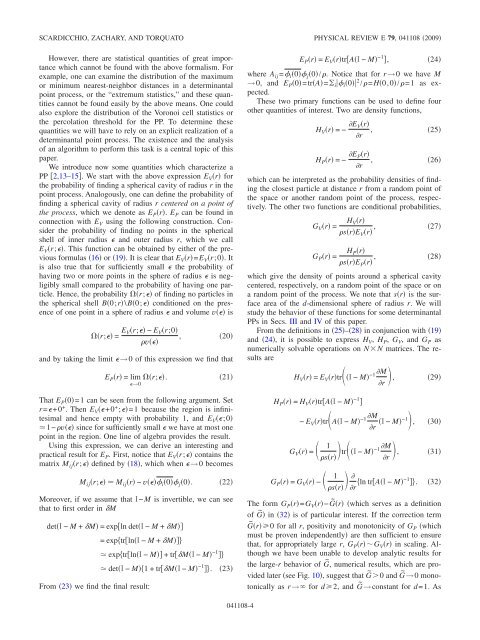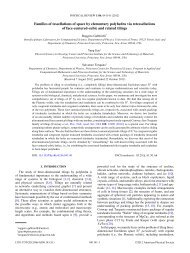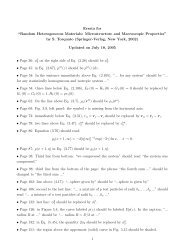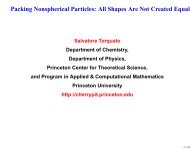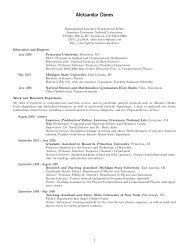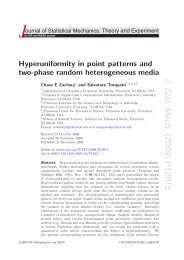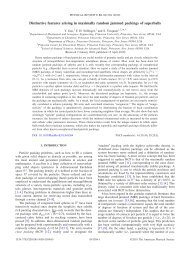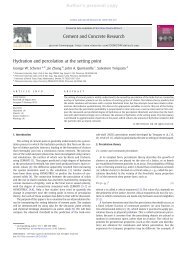Statistical properties of determinantal point processes in high ...
Statistical properties of determinantal point processes in high ...
Statistical properties of determinantal point processes in high ...
Create successful ePaper yourself
Turn your PDF publications into a flip-book with our unique Google optimized e-Paper software.
SCARDICCHIO, ZACHARY, AND TORQUATO PHYSICAL REVIEW E 79, 041108 2009<br />
However, there are statistical quantities <strong>of</strong> great importance<br />
which cannot be found with the above formalism. For<br />
example, one can exam<strong>in</strong>e the distribution <strong>of</strong> the maximum<br />
or m<strong>in</strong>imum nearest-neighbor distances <strong>in</strong> a <strong>determ<strong>in</strong>antal</strong><br />
<strong>po<strong>in</strong>t</strong> process, or the “extremum statistics,” and these quantities<br />
cannot be found easily by the above means. One could<br />
also explore the distribution <strong>of</strong> the Voronoi cell statistics or<br />
the percolation threshold for the PP. To determ<strong>in</strong>e these<br />
quantities we will have to rely on an explicit realization <strong>of</strong> a<br />
<strong>determ<strong>in</strong>antal</strong> <strong>po<strong>in</strong>t</strong> process. The existence and the analysis<br />
<strong>of</strong> an algorithm to perform this task is a central topic <strong>of</strong> this<br />
paper.<br />
We <strong>in</strong>troduce now some quantities which characterize a<br />
PP 2,13–15. We start with the above expression E Vr for<br />
the probability <strong>of</strong> f<strong>in</strong>d<strong>in</strong>g a spherical cavity <strong>of</strong> radius r <strong>in</strong> the<br />
<strong>po<strong>in</strong>t</strong> process. Analogously, one can def<strong>in</strong>e the probability <strong>of</strong><br />
f<strong>in</strong>d<strong>in</strong>g a spherical cavity <strong>of</strong> radius r centered on a <strong>po<strong>in</strong>t</strong> <strong>of</strong><br />
the process, which we denote as E Pr. E P can be found <strong>in</strong><br />
connection with E V us<strong>in</strong>g the follow<strong>in</strong>g construction. Consider<br />
the probability <strong>of</strong> f<strong>in</strong>d<strong>in</strong>g no <strong>po<strong>in</strong>t</strong>s <strong>in</strong> the spherical<br />
shell <strong>of</strong> <strong>in</strong>ner radius and outer radius r, which we call<br />
E Vr;. This function can be obta<strong>in</strong>ed by either <strong>of</strong> the previous<br />
formulas 16 or 19. It is clear that E Vr=E Vr;0. It<br />
is also true that for sufficiently small the probability <strong>of</strong><br />
hav<strong>in</strong>g two or more <strong>po<strong>in</strong>t</strong>s <strong>in</strong> the sphere <strong>of</strong> radius is negligibly<br />
small compared to the probability <strong>of</strong> hav<strong>in</strong>g one particle.<br />
Hence, the probability r; <strong>of</strong> f<strong>in</strong>d<strong>in</strong>g no particles <strong>in</strong><br />
the spherical shell B0;r\B0; conditioned on the presence<br />
<strong>of</strong> one <strong>po<strong>in</strong>t</strong> <strong>in</strong> a sphere <strong>of</strong> radius and volume v is<br />
r; = EVr; − EVr;0 , 20<br />
v<br />
and by tak<strong>in</strong>g the limit →0 <strong>of</strong> this expression we f<strong>in</strong>d that<br />
EPr = lim r;. 21<br />
→0<br />
That E P0=1 can be seen from the follow<strong>in</strong>g argument. Set<br />
r=+0 + . Then E V+0 + ;=1 because the region is <strong>in</strong>f<strong>in</strong>itesimal<br />
and hence empty with probability 1, and E V;0<br />
1−v s<strong>in</strong>ce for sufficiently small we have at most one<br />
<strong>po<strong>in</strong>t</strong> <strong>in</strong> the region. One l<strong>in</strong>e <strong>of</strong> algebra provides the result.<br />
Us<strong>in</strong>g this expression, we can derive an <strong>in</strong>terest<strong>in</strong>g and<br />
practical result for E P. First, notice that E Vr; conta<strong>in</strong>s the<br />
matrix M ijr; def<strong>in</strong>ed by 18, which when →0 becomes<br />
M ijr;M ijr − v i0 j0. 22<br />
Moreover, if we assume that I−M is <strong>in</strong>vertible, we can see<br />
that to first order <strong>in</strong> M<br />
detI − M + M = expln detI − M + M<br />
= exptrlnI − M + M<br />
exptrlnI − M +trMI− M−1 detI − M1+trMI− M−1. 23<br />
From 23 we f<strong>in</strong>d the f<strong>in</strong>al result:<br />
041108-4<br />
E Pr = E VrtrAI − M −1 , 24<br />
where Aij= i0 j0/. Notice that for r→0 we have M<br />
→0, and EP0=trA=ii02 /=H0,0/=1 as expected.<br />
These two primary functions can be used to def<strong>in</strong>e four<br />
other quantities <strong>of</strong> <strong>in</strong>terest. Two are density functions,<br />
HVr =− EVr , 25<br />
r<br />
HPr =− EPr , 26<br />
r<br />
which can be <strong>in</strong>terpreted as the probability densities <strong>of</strong> f<strong>in</strong>d<strong>in</strong>g<br />
the closest particle at distance r from a random <strong>po<strong>in</strong>t</strong> <strong>of</strong><br />
the space or another random <strong>po<strong>in</strong>t</strong> <strong>of</strong> the process, respectively.<br />
The other two functions are conditional probabilities,<br />
GVr = HVr , 27<br />
srEVr GPr = HPr , 28<br />
srEPr which give the density <strong>of</strong> <strong>po<strong>in</strong>t</strong>s around a spherical cavity<br />
centered, respectively, on a random <strong>po<strong>in</strong>t</strong> <strong>of</strong> the space or on<br />
a random <strong>po<strong>in</strong>t</strong> <strong>of</strong> the process. We note that sr is the surface<br />
area <strong>of</strong> the d-dimensional sphere <strong>of</strong> radius r. We will<br />
study the behavior <strong>of</strong> these functions for some <strong>determ<strong>in</strong>antal</strong><br />
PPs <strong>in</strong> Secs. III and IV <strong>of</strong> this paper.<br />
From the def<strong>in</strong>itions <strong>in</strong> 25–28 <strong>in</strong> conjunction with 19<br />
and 24, it is possible to express HV, HP, GV, and GP as<br />
numerically solvable operations on NN matrices. The results<br />
are<br />
H Vr = E VrtrI − M −1M<br />
r , 29<br />
H Pr = H VrtrAI − M −1 <br />
− E VrtrAI − M −1M<br />
r I − M−1, 30<br />
G Vr = 1<br />
srtrI − M −1M<br />
r , 31<br />
GPr = GVr − 1<br />
sr <br />
r ln trAI − M−1. 32<br />
The form G Pr=G Vr−G ˜ r which serves as a def<strong>in</strong>ition<br />
<strong>of</strong> G ˜ <strong>in</strong> 32 is <strong>of</strong> particular <strong>in</strong>terest. If the correction term<br />
G ˜ r0 for all r, positivity and monotonicity <strong>of</strong> G P which<br />
must be proven <strong>in</strong>dependently are then sufficient to ensure<br />
that, for appropriately large r, G PrG Vr <strong>in</strong> scal<strong>in</strong>g. Although<br />
we have been unable to develop analytic results for<br />
the large-r behavior <strong>of</strong> G ˜ , numerical results, which are provided<br />
later see Fig. 10, suggest that G ˜ 0 and G ˜ →0 monotonically<br />
as r→ for d2, and G ˜ →constant for d=1. As


